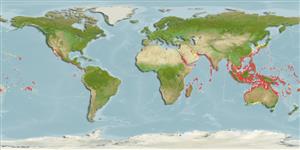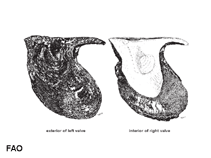Pteria penguin (Röding, 1798)
Penguin wing oyster| Native range | All suitable habitat | Point map | Year 2050 |

|
| This map was computer-generated and has not yet been reviewed. |
| Pteria penguin AquaMaps Data sources: GBIF OBIS |
Classification / Names Common names | Synonyms | CoL | ITIS | WoRMS
Bivalvia | Ostreida | Pteriidae
Environment: milieu / climate zone / depth range / distribution range Ecology
Benthic; depth range 0 - 35 m (Ref. 348), usually 0 - 35 m (Ref. 75831). Tropical
Distribution Countries | FAO areas | Ecosystems | Occurrences | Introductions
Indo-West Pacific: from East Africa and the Red Sea to Fiji Islands; north to southern Japan and south to northern Queensland and Western Australia.
Length at first maturity / Size / Weight / Age
Maturity: Lm ? range ? - ? cm Max length : 30.0 cm SHL male/unsexed; (Ref. 348); common length : 20.0 cm SHL male/unsexed; (Ref. 348)
Short description Morphology
Shell solid, reaching a very large size, obliquely ovate in outline, with posterior ear drawn out into a narrow, more or less elongated, wing-like expansion; slightly inequivalve, left valve a little more inflated and with a weak rounded fold radiating from umbo to posteroventral end of shell. Outline of shell variable, initially narrowly oblique, later greatly expanding ventrally and almost as high as long, or even higher than long in larger specimens and with the posterior ear relatively short. Interior of shell with a wide non-nacreous margin ventrally. Colour: outside of shell plain dark brown to black. Interior silvery and brilliantly nacreous, with a broad, posteroventrally expanded, glossy black margin.
Found in intertidal areas on rocks (Ref. 75831). Sometimes attached to sea whips (Ref. 799). Also found subtidal, on dead coral heads (Ref. 75840).
Life cycle and mating behavior Maturity | Reproduction | Spawning | Eggs | Fecundity | Larvae
Members of the class Bivalvia are mostly gonochoric, some are protandric hermaphrodites. Life cycle: Embryos develop into free-swimming trocophore larvae, succeeded by the bivalve veliger, resembling a miniature clam.
Main reference
References | Coordinator | Collaborators
SAUP Database. 2006. (Ref. 356)
IUCN Red List Status (Ref. 130435)
CITES status (Ref. 108899)
Not Evaluated
CMS (Ref. 116361)
Not Evaluated
Threat to humans
Human uses
Fisheries: commercial
FAO - Aquaculture: production; | FishSource | Sea Around Us
Tools
More information
Internet sources
BHL | BOLD Systems | CISTI | DiscoverLife | FAO(; publication : search) | Fishipedia | GenBank (genome, nucleotide) | GloBI | Gomexsi | Google Books | Google Scholar | Google | PubMed | Tree of Life | Wikipedia (Go, Search) | Zoological Record
Estimates based on models
Preferred temperature
(Ref. 115969): 24.2 - 29.1, mean 28 (based on 2122 cells).
Price category
(Ref. 80766):
Unknown.
Nutrients: Calcium = 149 [71, 228] mg/100g; Iron = 8.53 [1.95, 15.11] mg/100g; Protein = 9.88 [8.64, 11.12] %; Omega3 = 0.313 [0.202, 0.423] g/100g; Selenium = 61 [50, 72] μg/100g; VitaminA = 0 μg/100g; Zinc = 2.04 [0.56, 3.51] mg/100g (wet weight).



